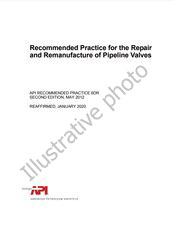We need your consent to use the individual data so that you can see information about your interests, among other things. Click "OK" to give your consent.

API STORAGETANKSET-2000
COLLECTION OF 11 API PUBLICATIONS THAT INCLUDES RECOMMENDED PRACTICES AND CONSTRUCTION, INSPECTION AND REPAIR STANDARDS FOR ABOVEGROUND STORAGE TANKS
Translate name
STANDARD published on 1.1.2000
| Language | |
| Format |
|
| Availability | IN STOCK |
| Price | ONREQUEST excl. VAT |
| ON REQUEST |
The information about the standard:
Designation standards: API STORAGETANKSET-2000
Publication date standards: 1.1.2000
SKU: NS-1139409
Approximate weight : 300 g (0.66 lbs)
Country: American technical standard
Category: Technical standards API
Annotation of standard text API STORAGETANKSET-2000 :
API STORAGE TANK SET, 2000 - COLLECTION OF 11 API PUBLICATIONS THAT INCLUDES RECOMMENDED PRACTICES AND CONSTRUCTION, INSPECTION AND REPAIR STANDARDS FOR ABOVEGROUND STORAGE TANKS
API STD 620: DESIGN AND CONSTRUCTION OF LARGE, WELDED, LOW-PRESSURE STORAGE TANKS
The API Downstream Segment has prepared this standard to cover large, field-assembled storage tanks of the type described in 1.2 that contain petroleum intermediates (gases or vapors) and finished products, as well as other liquid products commonly handled and stored by the various branches of the industry.
API STD 650: WELDED TANKS FOR OIL STORAGE
This standard establishes minimum requirements for material, design, fabrication, erection, and inspection for vertical, cylindrical, aboveground, closed- and open-top, welded storage tanks in various sizes and capacities for internal pressures approximating atmospheric pressure (internal pressures not exceeding the weight of the roof plates), but a higher internal pressure is permitted when additional requirements are met (see 1.1.13). This standard applies only to tanks whose entire bottom is uniformly supported and to tanks in non-refrigerated service that have a maximum design temperature of 93 °C (200 °F) or less.
API STD 653: TANK INSPECTION, REPAIR, ALTERATION, AND RECONSTRUCTION
This standard covers steel storage tanks built to API 650 and its predecessor API 12C. It provides minimum requirements for maintaining the integrity of such tanks after they have been placed in service and addresses inspection, repair, alteration, relocation, and reconstruction.
API STD 2015: REQUIREMENTS FOR SAFE ENTRY AND CLEANING OF PETROLEUM STORAGE TANKS
This standard is applicable to stationary atmospheric and low-pressure (up to and including 15 psig) aboveground petroleum storage tanks used in all sectors of the petroleum and petrochemical industry, including: crude oil and gas production, refining, petrochemicals, pipelines and terminals, bulk storage, ethanol facilities. This standard provides requirements for safely planning, coordinating, and conducting tank entry and cleaning operations, from removal from service through return to service. This standard does not and cannot cover every possible unique hazard or situation that may arise during tank cleaning operations. Site, product, and tank-specific hazards and situations must be addressed by employers using the appropriate principles and considerations provided for by this standard.
API RP 651: CATHODIC PROTECTION OF ABOVEGROUND PETROLEUM STORAGE TANKS The purpose of this recommended practice (RP) is to present procedures and practices for achieving effective corrosion control on aboveground storage tank bottoms through the use of cathodic protection. This RP contains provisions for the application of cathodic protection to existing and new aboveground storage tanks. Corrosion control methods based on chemical control of the environment or the use of protective coatings are not covered in detail.
API RP 652: LININGS OF ABOVEGROUND PETROLEUM STORAGE TANK BOTTOMS
This recommended practice (RP) provides guidance on achieving effective corrosion control in aboveground storage tanks by application of tank bottom linings. It contains information pertinent to the selection of lining materials, surface preparation, lining application, cure, and inspection of tank bottom linings for existing and new storage tanks. In many cases, tank bottom linings have proven to be an effective method of preventing internal corrosion of steel tank bottoms.
API RP 2016: GUIDELINES AND PROCEDURES FOR ENTERING AND CLEANING PETROLEUM STORAGE TANKS
ANSI/API Recommended Practice 2016, First Edition, Guidelines and Procedures for Entering and Cleaning Petroleum Storage Tanks, supplements the requirements of ANSI/API Standard 2015, Sixth Edition, Requirements for Safe Entry and Cleaning of Petroleum Storage Tanks. This recommended practice provides guidance and information on the specific aspects of tank cleaning, in order to assist employers (owners/operators and contractors) to conduct safe tank cleaning operations in accordance with the requirements of ANSI/API Standard 2015.
API RP 2207: PREPARING TANK BOTTOMS FOR HOT WORK
This recommended practice addresses only the safety aspects of hot work on petroleum storage tank bottoms. It discusses safety precautions for preventing fires, explosions and associated injuries. The term hot work, as used in this publication, is defined as an operation that can produce a spark or flame hot enough to ignite flammable vapors. API 2009 provides more in-depth information on safe hot work practices and its requirements are not duplicated here.
API RP 2021: MANAGEMENT OF ATMOSPHERIC STORAGE TANK FIRES
This recommended practice provides experience-based information to enhance the understanding of fires in atmospheric storage tanks containing flammable and combustible materials. It presents a systematic management approach which can assist tank fire prevention. If fires do occur, this information can help responders optimize fire suppression techniques to reduce the severity of an incident and reduce the potential for escalation.
API STD 625: TANK SYSTEMS FOR REFRIGERATED LIQUEFIED GAS STORAGE
This standard covers low pressure, aboveground, vertical, and cylindrical tank systems storing liquefied gases requiring refrigeration. This standard provides general requirements on responsibilities, selection of storage concept, performance criteria, accessories/appu
We recommend:
Technical standards updating
Do you want to make sure you use only the valid technical standards?
We can offer you a solution which will provide you a monthly overview concerning the updating of standards which you use.
Would you like to know more? Look at this page.



 Cookies
Cookies
